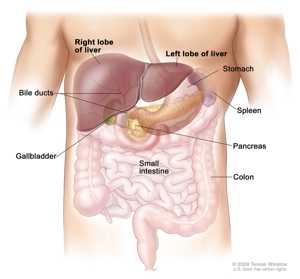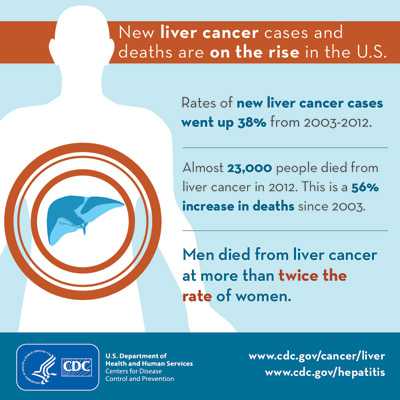Liver Cancer

Anatomy of the liver. The liver is in the upper abdomen near the stomach, intestines, gallbladder, and pancreas. The liver has four lobes. Two lobes are on the front and two small lobes (not shown) are on the back of the liver. Click to see a larger diagram.
© 2010 Terese Winslow LLC, U.S. Govt. has certain rights. Used with Permission. Contact artist at www.teresewinslow.com for licensing.
Cancer is a disease in which cells in the body grow out of control. When cancer starts in the liver, it is called liver cancer. Each year in the United States, about 22,000 men and 9,000 women get liver cancer, and about 16,000 men and 8,000 women die from the disease. The percentage of Americans who get liver cancer has been rising for several decades.
To lower your risk for liver cancer, get vaccinated against Hepatitis B, get tested for Hepatitis C, and don’t drink too much alcohol.
What Is the Liver?
The liver is the largest organ in the human body, located on the upper right side of the body, behind the lower ribs. The liver does many jobs, including—
- Storing nutrients.
- Removing waste products and worn-out cells from the blood.
- Filtering and processing chemicals in food, alcohol, and medications.
- Producing bile, a solution that helps digest fats and eliminate waste products.
What Causes Liver Cancer?
Many liver cancer cases are related to the hepatitis B virus or hepatitis C virus. More than 4 million people are living with chronic Hepatitis B or chronic Hepatitis C in the United States. Most people don’t know they have the virus.
Other behaviors and conditions that increase risk for getting liver cancer are—
- Heavy alcohol use.
- Cirrhosis (scarring of the liver, which can also be caused by hepatitis and alcohol use).
- Obesity.
- Diabetes.
- Having hemochromatosis, a condition where the body takes up and stores more iron than it needs.
- Eating foods that have aflatoxin (a fungus that can grow on foods, such as grains and nuts that have not been stored properly).
What Are the Symptoms of Liver Cancer?
In its early stages, liver cancer may not have symptoms that can be seen or felt. However, as the cancer grows larger, people may notice one or more of these common symptoms. It’s important to remember that these symptoms could also be caused by other health conditions. If you have any of these symptoms, talk to your doctor.
Liver cancer symptoms may include—
- Discomfort in the upper abdomen on the right side.
- A swollen abdomen.
- A hard lump on the right side just below the rib cage.
- Pain near the right shoulder blade or in the back.
- Jaundice (yellowing of the skin and whites of the eyes).
- Easy bruising or bleeding.
- Unusual tiredness.
- Nausea and vomiting.
- Loss of appetite.
- Weight loss for no known reason.
How Can I Reduce My Risk for Liver Cancer?

New liver cancer cases and deaths are on the rise in the United States. Rates of new liver cancer cases went up 38% from 2003 to 2012. Almost 23,000 people died from liver cancer in 2012. This is a 56% increase in deaths since 2003. Men died from liver cancer at more than twice the rate of women.
You can lower your risk of getting liver cancer in the following ways—
- Get vaccinated against Hepatitis B infection. The Hepatitis B vaccine is recommended for all infants at birth and for adults who may be at increased risk.
- Get tested for Hepatitis C, and get treated if you have it.
- Avoid drinking too much alcohol.
Statistics
In the United States in 2014 (the most recent year numbers are available)—
- 31,411 people (22,472 men and 8,939 women) were diagnosed with liver cancer.
- 24,598 people (16,623 men and 8,075 women) died from liver cancer.
- Among men, Hispanic† men had the highest rates of getting liver cancer (20.1 per 100,000 men), followed by Asian/Pacific Islander men (18.4), black men (17.0), American Indian/Alaska Native men (15.7), and white men (11.2).
- Among women, Hispanic† women had the highest rates of getting liver cancer (7.7 per 100,000 women), followed by Asian/Pacific Islander women (7.6), American Indian/Alaska Native women (6.8), black women (5.0), and white women (4.0).
- Among Asian/Pacific Islander men, liver cancer was the fourth most common cancer and the second most common cause of cancer death.
- Among Asian/Pacific Islander women, liver cancer was the ninth most common cancer and the fifth most common cause of cancer death.
†Hispanic origin is not mutually exclusive from race categories (white, black, Asian/Pacific Islander, American Indian/Alaska Native).
Data source: U.S. Cancer Statistics Working Group. United States Cancer Statistics: 1999–2014 Incidence and Mortality Web-based Report. Atlanta (GA): Department of Health and Human Services, Centers for Disease Control and Prevention, and National Cancer Institute; 2017. Available at: http://www.cdc.gov/uscs.
More Information
- Blog post: I Have Liver Cancer, But You Don’t Have To
- What You Need to Know About Liver Cancer (National Cancer Institute)
- Liver and Bile Duct Cancer (National Cancer Institute)
- Viral Hepatitis (CDC)
- Know More Hepatitis campaign (CDC)
- Know Hepatitis B campaign (CDC)
- CDC Statement on Liver Cancer and Hepatitis
- Hepatitis and Liver Cancer: A National Strategy for Prevention and Control of Hepatitis B and C (Institute of Medicine)
- Page last reviewed: June 6, 2017
- Page last updated: June 6, 2017
- Content source: Error processing SSI file


 ShareCompartir
ShareCompartir